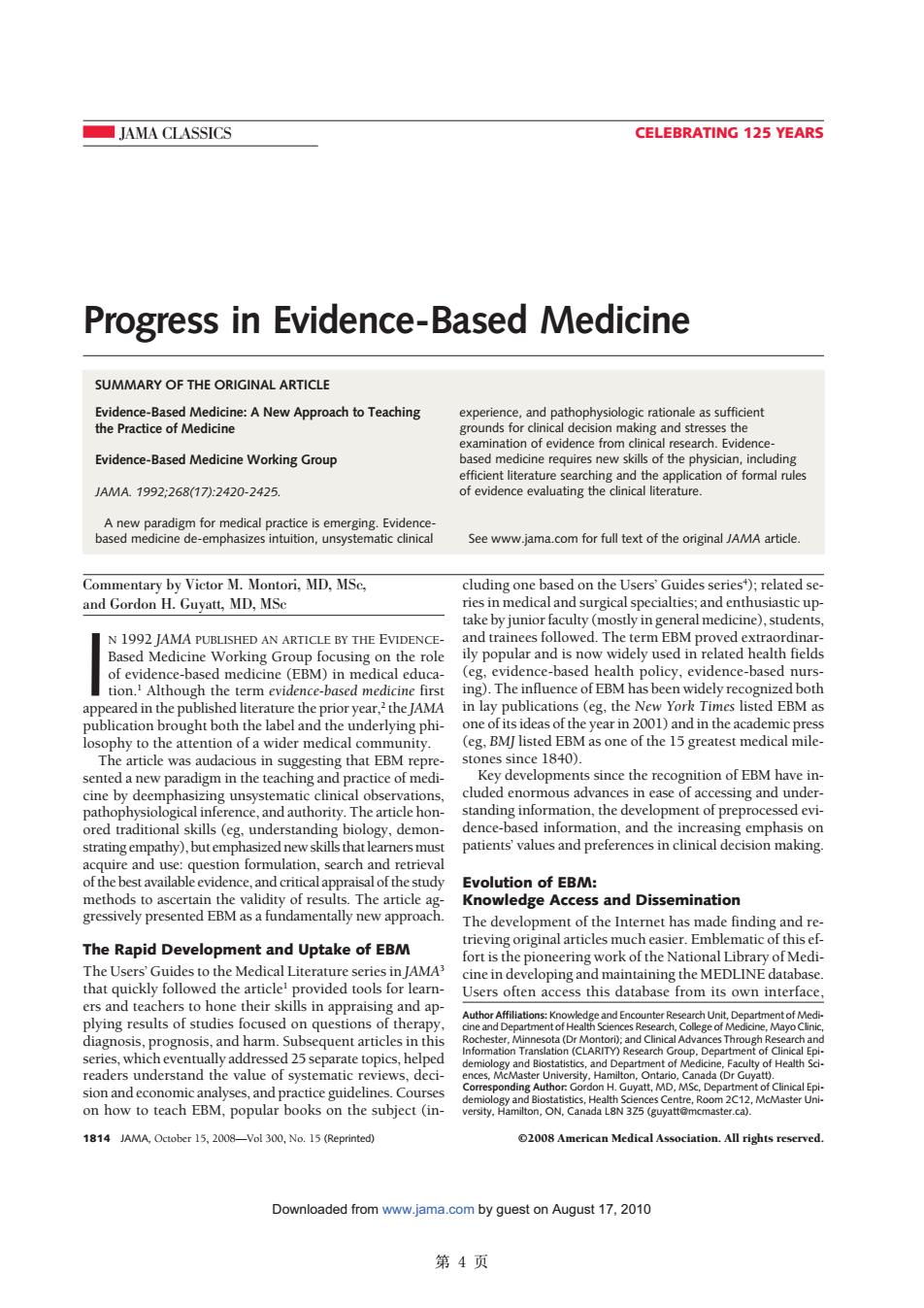正在加载图片...

■JAMA CLASSICS CELEBRATING 125 YEARS Progress in Evidence-Based Medicine SUMMARY OF THE ORIGINAL ARTICLE 8 a Evidence-Based Medicine Working Grou MA1992-268/172420-2425. wjama.com for full text of the ake by( ral medicine),student ly popular and is ly used in The mu e in tanding information,the dev oment of preproces sed evi red traditio The article new appre The development of the has made finding and The Rapid Develo and Uptake of EBM agno n Group.De of readers understand the value of t.MD.M 814A015.200 C2008 Ame Downloaded from www.iama.com by quest on August 17.2010 第4页JAMA CLASSICS CELEBRATING 125 YEARS Progress in Evidence-Based Medicine SUMMARY OF THE ORIGINAL ARTICLE Evidence-Based Medicine: A New Approach to Teaching the Practice of Medicine Evidence-Based Medicine Working Group JAMA. 1992;268(17):2420-2425. A new paradigm for medical practice is emerging. Evidencebased medicine de-emphasizes intuition, unsystematic clinical experience, and pathophysiologic rationale as sufficient grounds for clinical decision making and stresses the examination of evidence from clinical research. Evidencebased medicine requires new skills of the physician, including efficient literature searching and the application of formal rules of evidence evaluating the clinical literature. See www.jama.com for full text of the original JAMA article. Commentary by Victor M. Montori, MD, MSc, and Gordon H. Guyatt, MD, MSc I N 1992 JAMA PUBLISHED AN ARTICLE BY THE EVIDENCEBased Medicine Working Group focusing on the role of evidence-based medicine (EBM) in medical education.1 Although the term evidence-based medicine first appeared in the published literature the prior year,2 the JAMA publication brought both the label and the underlying philosophy to the attention of a wider medical community. The article was audacious in suggesting that EBM represented a new paradigm in the teaching and practice of medicine by deemphasizing unsystematic clinical observations, pathophysiological inference, and authority. The article honored traditional skills (eg, understanding biology, demonstrating empathy), but emphasized new skills thatlearnersmust acquire and use: question formulation, search and retrieval of the best available evidence, and critical appraisal of the study methods to ascertain the validity of results. The article aggressively presented EBM as a fundamentally new approach. The Rapid Development and Uptake of EBM The Users’ Guides to the Medical Literature series in JAMA3 that quickly followed the article1 provided tools for learners and teachers to hone their skills in appraising and applying results of studies focused on questions of therapy, diagnosis, prognosis, and harm. Subsequent articles in this series, which eventually addressed 25 separate topics, helped readers understand the value of systematic reviews, decision and economic analyses, and practice guidelines. Courses on how to teach EBM, popular books on the subject (including one based on the Users’ Guides series4 ); related series in medical and surgical specialties; and enthusiastic uptake by junior faculty (mostly in general medicine), students, and trainees followed. The term EBM proved extraordinarily popular and is now widely used in related health fields (eg, evidence-based health policy, evidence-based nursing). The influence of EBM has been widely recognized both in lay publications (eg, the New York Times listed EBM as one of its ideas of the year in 2001) and in the academic press (eg, BMJ listed EBM as one of the 15 greatest medical milestones since 1840). Key developments since the recognition of EBM have included enormous advances in ease of accessing and understanding information, the development of preprocessed evidence-based information, and the increasing emphasis on patients’ values and preferences in clinical decision making. Evolution of EBM: Knowledge Access and Dissemination The development of the Internet has made finding and retrieving original articles much easier. Emblematic of this effort is the pioneering work of the National Library of Medicine in developing and maintaining the MEDLINE database. Users often access this database from its own interface, Author Affiliations: Knowledge and Encounter Research Unit, Department of Medicine and Department of Health Sciences Research, College of Medicine, Mayo Clinic, Rochester, Minnesota (Dr Montori); and Clinical Advances Through Research and Information Translation (CLARITY) Research Group, Department of Clinical Epidemiology and Biostatistics, and Department of Medicine, Faculty of Health Sciences, McMaster University, Hamilton, Ontario, Canada (Dr Guyatt). Corresponding Author: Gordon H. Guyatt, MD, MSc, Department of Clinical Epidemiology and Biostatistics, Health Sciences Centre, Room 2C12, McMaster University, Hamilton, ON, Canada L8N 3Z5 (guyatt@mcmaster.ca). 1814 JAMA, October 15, 2008—Vol 300, No. 15 (Reprinted) ©2008 American Medical Association. All rights reserved. Downloaded from www.jama.com by guest on August 17, 2010 第 4 页